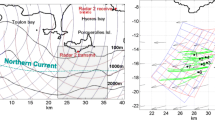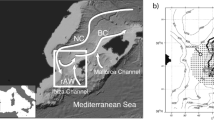Abstract
High-frequency (HF) radar-derived ocean currents are compared with in situ measurements to conclude if the radar observations include effects of surface waves that are of second order in the wave amplitude. Eulerian current measurements from a high-resolution acoustic Doppler current profiler and Lagrangian measurements from surface drifters are used as references. Directional wave spectra are obtained from a combination of pressure sensor data and a wave model. Our analysis shows that the wave-induced Stokes drift is not included in the HF radar-derived currents, that is, HF radars measure the Eulerian current. A disputed nonlinear correction to the phase velocity of surface gravity waves, which may affect HF radar signals, has a magnitude of about half the Stokes drift at the surface. In our case, this contribution by nonlinear dispersion would be smaller than the accuracy of the HF radar currents, hence no conclusion can be made. Finally, the analysis confirms that the HF radar data represent an exponentially weighted vertical average where the decay scale is proportional to the wavelength of the transmitted signal.







Similar content being viewed by others
References
Ardhuin F, Marie L, Rascle N, Forget P, Roland A (2009) Observation and estimation of lagrangian, stokes, and eulerian currents induced by wind and waves at the sea surface. J Phys Oceanogr 39(11):2820–2838. doi:10.1175/2009JPO4169.1
Barrick DE, Weber BL (1977) On the nonlinear theory for gravity waves on the ocean’s surface. part ii: Interpretation and applications. J Phys Oceanogr 7(1):11–21
Breivik O, Allen A, Maisondieu C, Olagnon M (2013) Advances in Search and Rescue at Sea. Ocean Dynam 63:83–88. doi:10.1007/s10236-012-0581-1
Breivik Ø, Janssen PEAM, Bidlot JR (2014) Approximate stokes drift profiles in deep water. J Phys Oceanogr 44:2433–2445. doi:10.1175/JPO-D-14-0020.1
Broche P, de Maistre JC, Forget P (1983) Mesure par radar dcamtrique cohrent des courants superficiels engendrs par le vent. Oceanol Acta 6:43–53
Chapman RD, Graber HC (1997) Validation of hf radar measurements. Oceanography 10:76–79. doi:10.5670/oceanog.1997.28
Creamer DB, Henyey F, J Wright RS (1989) Improved linear representation of ocean surface waves. J Fluid Mech 205:135–161. doi:10.1017/S0022112089001977
Davis RE (1985) Drifter observations of coastal surface currents during CODE: The method and descriptive view. J Geophys Res 90(C3):4741–4755. doi:10.1029/JC090iC03p04741
Emery BM, Washburn L, Harlan JA (2004) Evaluating radial current measurements from codar high-frequency radars with moored current meters. J Atmos Ocean Tech 21(8):1259–1271
Emery W, Thomson RE (1997) Data Analysis Methods in Physical Oceanography. Elsevier, Amsterdam
Everitt B (2003) The Cambridge Dictionary of Statistics. Cambridge Univ Press
Graber HC, Haus BK, Chapman RD, Shay LK (1997) HF radar comparisons with moored estimates of current speed and direction: Expected differences and implications. J Geophys Res 102 C8:18 766:749–18. doi:10.1029/97JC01190
Janssen P (2009) On some consequences of the canonical transformation in the Hamiltonian theory of water waves. J Fluid Mech 637(1):1–44. doi:10.1017/S0022112009008131
Komen GJ, Cavaleri L, Doneland M, Hasselmann K, Hasselmann S, Janssen PAE (1994) Dynamics and modelling of ocean waves
Law K (2001) Measurements of near surface ocean currents using hf radar. PhD thesis, University of California Santa Cruz
Liu Y, Weisberg RH, Merz CR (2014) Assessment of codar seasonde and wera hf radars in mapping surface currents on the west florida shelf. J Atmos Ocean Tech 31:1363–1382. doi:10.1175/JTECH-D-13-00107.1
Ohlmann C, White P, Washburn L, Terrill E, Emery B, Otero M (2007) Interpretation of coastal hf radar-derived surface currents with high-resolution drifter data. J Atmos Ocean Tech 24:666–680. doi:10.1175/JTECH1998.1
Paduan JD, Washburn L (2013) High-frequency radar observations of ocean surface currents. Annu RevMarine Sci 5:115–136. doi:10.1146/annurev-marine-121211-172315
Röhrs J, Christensen KH, Hole LR, Broström G, Drivdal M, Sundby S (2012) Observation-based evaluation of surface wave effects on currents and trajectory forecasts. Ocean Dynam 62:1519–1533. doi:10.1007/s10236-012-0576-y
Schmidt (1986) Multiple emitter location and signal parameter estimation. IEEE T Antenn Propag 34-3:276–280. doi:10.1109/TAP.1986.1143830
Sperrevik AK, Christensen KH, Röhrs J (2015) Constraining energetic slope currents through assimilation of high-frequency radar observations. Ocean Sci 11:237–249. doi:10.5194/os-11-237-2015
Stewart RH, Joy JW (1974) HF radio measurements of surface currents. Deep Sea Res 21:1039–1049. doi:10.1016/0011-7471(74)90066-7
Stokes GG (1847) On the theory of oscillatory waves. Trans Cambridge Philos Soc 8:441–473
Teague C, Vesecky J, Hallock Z (2001) A comparison of multifrequency hf radar and adcp measurements of near-surface currents during cope-3. IEEE J Ocean Eng 26(3):399–405. doi:10.1109/48.946513
Zhang WG, Wilkin JL, Arango HG (2010) Towards an integrated observation and modeling system in the New York Bight using variational methods. Part I: 4DVAR data assimilation. Ocean Model 35:119–133. doi:10.1016/j.ocemod.2010.08.003
Acknowledgments
This work was funded by the Norwegian Clean Seas Association For Operating Companies (NOFO) and ENI Norge A/S, with contributions from the Research Council of Norway (196438/BIOWAVE and 207541/OILWAVE). The contribution by Ø.B. was carried out as part of the European Union FP7 project MyWave (grant no 284455). The authors would like to thank Svein Sundby and Frode Vikebø (IMR) for helpful discussions and kind assistance during the planning phase, and Erik Berg (IMR), as well as the captain and crew of R/V Johan Hjort, for their kind assistance with the drifter deployments. We would also like to thank Ronald Pedersen (IMR), Tor Gammelsrød (UiB), Erik Kvaleberg, and Anne Hesby (Royal Norwegian Navy) for loan of instruments and assistance with the ADCP rig. Assistance from the captains and crews of the NSO Crusader and R/V Håkon Mosby when deploying and recovering the ADCP rig is also gratefully acknowledged.
Author information
Authors and Affiliations
Corresponding author
Additional information
Responsible Editor: Matthew Robert Palmer
Rights and permissions
About this article
Cite this article
Röhrs, J., Sperrevik, A.K., Christensen, K.H. et al. Comparison of HF radar measurements with Eulerian and Lagrangian surface currents. Ocean Dynamics 65, 679–690 (2015). https://doi.org/10.1007/s10236-015-0828-8
Received:
Accepted:
Published:
Issue Date:
DOI: https://doi.org/10.1007/s10236-015-0828-8




